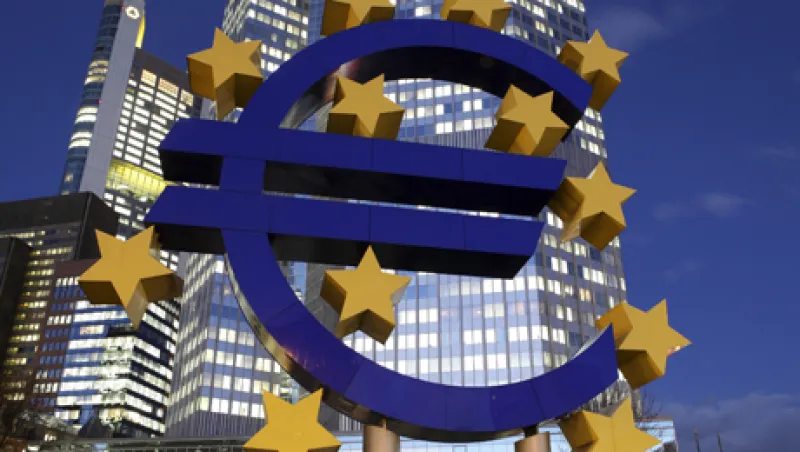The euro zone has returned to recession, according to a prestigious survey closely watched by central bankers and economists.
Output in the currency union has fallen for the second straight month, according to the March Purchasing Managers' Index (PMI) published by Markit Economics — and the decline has accelerated.
The news will reawaken the debate about whether the European Central Bank and euro zone politicians are doing enough to save the economy from a serious slump.
Chris Williamson, chief economist at Markit, said, “The further drop in the PMI is clearly a disappointment following the brief return to growth seen in January and suggests that policymakers will need to seek ways to revive economic growth across the region again.”
The March PMI numbers painted a less sunny picture than before for Germany and France, which largely caused the deterioration in the euro zone as a whole. In particular, the powerful German manufacturing sector has put in a disappointing performance. Output showed anemic growth this month after a strong showing in February.
The composite index of output for the euro zone as a whole, including both manufacturing and private-sector services, fell to 48.7 from 49.3. Any figure below 50 means a contraction in output.
The PMI figures suggest that the euro zone has entered recession — most commonly defined as two straight quarters of falling output. Official figures show a 0.3 percent decrease in euro zone gross domestic product (GDP) in the fourth quarter of last year. Economists said the Markit PMI numbers for January to March indicate a further fall in the first quarter of 0.1 percent or 0.2 percent.
This adds up to a mild recession (in contrast to the deep recession of 2009). Markit’s March survey of purchasing managers, however, has set economists and investors fretting about two worrying questions: how long will the recession last, and what are policymakers willing and able to do to end it?
The volume of new business fell at its sharpest pace since December, the survey suggests, pushing backlogs of work down for the ninth straight month. This indicates that output could fall again in April. Companies continued to reduce headcount in March — a sign that they do not see a quick end to the slump.
In the short to medium term, politicians’ power to end the decline in output is extremely limited. Last year’s abrupt rises in euro zone sovereign bond yields forced most member states to trim government budgets sharply in order to bring yields back down by restoring fiscal credibility. Falling output is more likely to prompt politicians to reduce spending even further rather than increase it, since declining economic activity increases fiscal deficits by reducing tax revenue. Yet the politicians seem to have ruled out Keynesian measures to use government spending to stimulate demand. Euro zone governments’ current attempts to boost economic growth — through improving access to the professions and cutting bureaucratic burdens on business, for example — are likely to boost GDP only in the longer term.
The ECB will be reluctant to cut the cost of borrowing any further, given the recent stubborn refusal of euro zone inflation to fall further towards the 2 percent level, which it regards as the maximum acceptable level. Inflation was 2.7 percent in February for the third consecutive month.
Stella Wang, European economist at Nomura in London, said the PMI report “increases our conviction” that the ECB will keep its benchmark interest rate at 1 percent. She concluded, “With headline inflation currently set to remain above 2 percent throughout 2012, a rate cut at this stage would be a tough sell.”
The ECB has the alternative option of resorting to unconventional measures to boost the economy. Many analysts think its December decision to offer unlimited three-year funding to euro zone banks through its long-term refinancing operation (LTRO) saved the region from another credit crunch, which would have ushered in a recession perhaps even deeper than the slump that followed the crunch of 2008. The ECB lent hundreds of billions of euros once again at the end of February through a second three-year LTRO.
But it looks unlikely that the ECB will take such radical action again unless the euro zone’s economic plight becomes considerably worse. Mario Draghi, the ECB president, is facing criticism from officials at the Bundesbank — Germany’s conservative and powerful central bank — over the unconventional measures taken so far. He might find it politically impossible to go further down the same road. In any case, economists argue that the two LTROs have already done all that can be expected of them: they have saved the currency union’s banks from going bust. These economists say that as long as demand in the real euro zone economy remains so low, banks will be reluctant to use the new funds to boost output by lending to businesses. In any case, the ECB’s latest survey of bank lending suggests that demand among businesses for bank loans remains tepid because of the uncertain economic outlook.
The Eurofirst 300 index of euro zone stocks responded to the weak PMI data by dropping 1.1 percent to 1,079 on Thursday. Yields on the benchmark Italian 10-year bond — which is sensitive to any signs that a weakening euro zone economy will make the government’s debt burden unsustainable — rose by 10 basis points to 5.09 percent.






